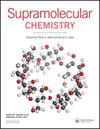对环己基杯[4]芳烃的结构、衍生化和金属络合
IF 2.6
4区 化学
Q3 CHEMISTRY, MULTIDISCIPLINARY
引用次数: 0
摘要
由于对杯[4]芳烃对金属络合和结构化学的影响感兴趣,对环己基杯[4]芳烃(L)进行了研究。1:1的二氯甲烷和二甲基甲酰胺溶剂化物是同结构的,不同于对叔丁基杯[4]芳烃溶剂化物的典型双层结构。相反,甲醇溶剂化物确实形成了双层结构,但也是1:1的溶剂化物,这与对叔丁基杯[4]芳烃·2MeOH体系不同。研究了类镧络合作用,得到了2:2二聚体铕络合物Eu2(L-3H)2(DMF)4的两种DMF溶剂化物的结构表征。以中间体5,11,17,23-四环己基-25,27-二羟基-26,28-双(四唑-5-基甲氧基)杯[4]芳烃为原料合成了一种四唑衍生物5,11,17,23-四环己基-25,27-二羟基-26,28-二氰甲氧基杯[4]芳烃,并对后者进行了结构表征。在已知与对丁基类似物形成Ln19簇的条件下,试图分离由四唑衍生物支持的类镧簇是不成功的,只导致从反应混合物中分离出配体。图形抽象本文章由计算机程序翻译,如有差异,请以英文原文为准。
Structure, derivatisation, and metal complexation of p-cyclohexylcalix[4]arene
ABSTRACT Driven by an interest in the impact of the para-substituent of calix[4]arenes on metal complexation and structural chemistry, studies of p-cyclohexylcalix[4]arene (L) have been carried out. The 1:1 dichloromethane and dimethylformamide solvates were found to be isostructural, and different to the typical bilayer structure often observed for p-t-butylcalix[4]arene solvates. The methanol solvate, in contrast, does form a bilayered structure but is also a 1:1 solvate, unlike the p-t-butylcalix[4]arene·2MeOH system. Lanthanoid complexation was investigated, resulting in the structural characterisation of two different DMF solvates of a 2:2 dimeric europium complex, Eu2(L–3H)2(DMF)4. A tetrazole derivative, 5,11,17,23-tetracyclohexyl-25,27-dihydroxy-26,28-bis(tetrazole-5-ylmethoxy)calix[4]arene, has been synthesised via the intermediate 5,11,17,23-tetracyclohexyl-25,27-dihydroxy-26,28-dicyanomethoxycalix[4]arene, with the latter compound being structurally characterised. Attempts to isolate lanthanoid clusters supported by the tetrazole derivative under conditions known to form Ln19 clusters with the p-t-butyl analogue were unsuccessful, resulting only in isolation of the ligand from the reaction mixture. Graphical abstract
求助全文
通过发布文献求助,成功后即可免费获取论文全文。
去求助
来源期刊

Supramolecular Chemistry
化学-化学综合
CiteScore
3.60
自引率
3.00%
发文量
5
审稿时长
2.7 months
期刊介绍:
Supramolecular Chemistry welcomes manuscripts from the fields and sub-disciplines related to supramolecular chemistry and non-covalent interactions. From host-guest chemistry, self-assembly and systems chemistry, through materials chemistry and biochemical systems, we interpret supramolecular chemistry in the broadest possible sense. Interdisciplinary manuscripts are particularly encouraged. Manuscript types include: high priority communications; full papers; reviews, and; Methods papers, techniques tutorials highlighting procedures and technologies that are important to the field. We aim to publish papers in a timely fashion and as soon as a paper has been accepted and typeset it will be published in electronic form on the Latest articles section of the website. The two most important review criteria are that the paper presents high-quality work that fits generally into the broad spectrum of activities in the supramolecular chemistry field. Under normal circumstances, Supramolecular Chemistry does not consider manuscripts that would be more suitable in a highly specialized journal. This includes, but is not limited to, those based mostly or exclusively on topics such as solid state/X-ray structures, computational chemistry, or electrochemistry. .
The two most important review criteria are that the paper presents high-quality work that fits generally into the broad spectrum of activities in the supramolecular chemistry field.
 求助内容:
求助内容: 应助结果提醒方式:
应助结果提醒方式:


